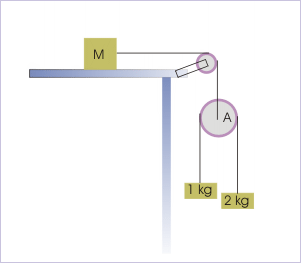| << Chapter < Page | Chapter >> Page > |
Questions and their answers are presented here in the module text format as if it were an extension of the treatment of the topic. The idea is to provide a verbose explanation, detailing the application of theory. Solution presented is, therefore, treated as the part of the understanding process – not merely a Q/A session. The emphasis is to enforce ideas and concepts, which can not be completely absorbed unless they are put to real time situation.
We discuss problems, which highlight certain aspects of the study leading to working with pulleys. The questions are categorized in terms of the characterizing features of the subject matter :
Problem 1 : In the arrangement, find the mass “M” such that block of mass 1 kg moves with uniform velocity. Neglect mass of the pulleys and the string. Also neglect friction between the surfaces.
Block and pulley system

Solution : The block of mass 1 kg moves with constant velocity with respect to ground. It means that there is no net external force on the block. Let us denote block of mass 1 kg and 2 kg by the subscripts “1” and “2” respectively.
Now, forces on the block of mass 1 kg, are (i) its weight, “ ”, acting downward and (i) tension in the string, say “ ”, acting upward. The two forces form a balanced force system as block moves with uniform velocity. Hence,
Free body diagrams

From the force analysis of the moving mass-less pulley, "A",
Combining two equations,
Tension is the only force on the block, which is placed on the horizontal surface of the table. From the force analysis of the block on the horizontal surface (see FBD of block in the figure below), we have :
This is also the acceleration of moving pulley as it is connected to the block on the table with a string. If we consider upward direction as positive, then acceleration of the moving pulley is :
Free body diagram

From the expression of acceleration of moving pulley, it is clear that we should get an equation involving acceleration of moving pulley in order to ultimately determine the value of "M" as required. According to question, the block of mass “1 kg” travels with zero acceleration (constant velocity) with reference to ground. The force analysis of this mass, therefore, does not involve acceleration of the moving pulley. Thus, we shall strive to find the acceleration of block of "2 kg" with respect to ground as its expression will involve acceleration of the moving pulley. Since block of mass “1 kg” travels with zero acceleration (constant velocity) with reference to ground, its acceleration with respect to moving pulley is :
We shall, however, take advantage of the fact that acceleration of block of 1 kg has zero acceleration with respect to ground reference. Its acceleration with respect to moving pulley is :

Notification Switch
Would you like to follow the 'Physics for k-12' conversation and receive update notifications?